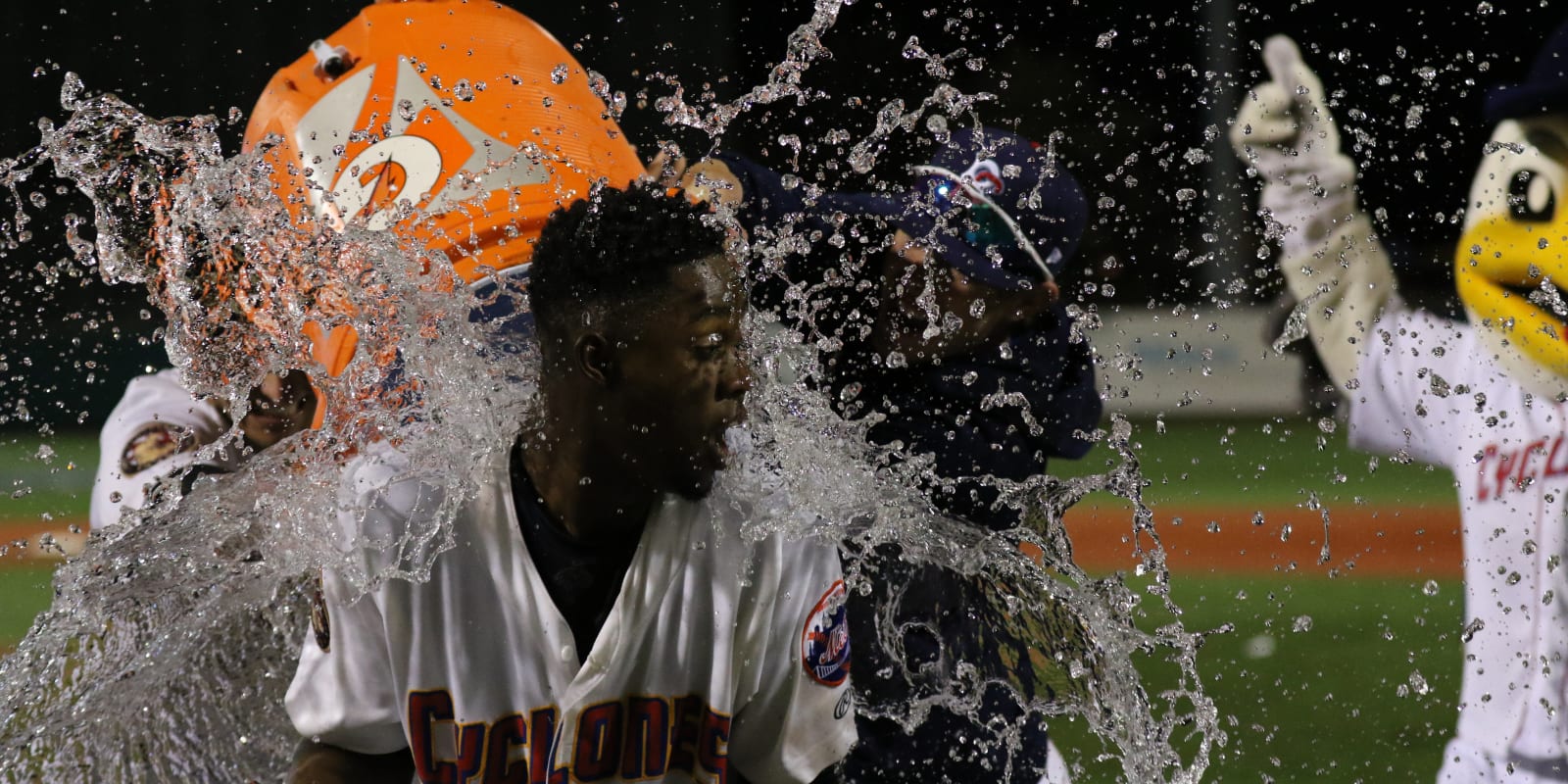At its core all baseball is regional. For millions of fans, a shrinking Minor League Baseball apparatus endangers their traditions and fan communities.
Three hot dogs burst out of the gate behind the foul pole and race down the third baseline. The dogs represent ketchup, mustard and relish, as evidenced by the red, yellow and green squiggles on their respective costumes. Ketchup theatrically trips Mustard, and Mustard stumbles into the infield. Relish takes advantage of the drama, surges into the lead and crosses home plate triumphantly.
This is Brooklyn Cyclones baseball, and don’t you forget it.
Yes, baseball. This hot dog race happens at the top of the seventh inning during every Cyclones home game. The Brooklyn Cyclones are now the New York Mets’ high-A farm team. Their stadium, MCU Park, is located just behind the renowned Coney Island boardwalk, a short walk from the team’s namesake roller coaster, the 94-year-old wooden Cyclone. The original Nathan’s Famous is just four blocks away. If you aren’t a Brooklynite, you might recognize Nathan’s as the home of the hot dog eating contest broadcast live on ESPN every July 4.
The Cyclones emerged from the massive restructuring of Minor League Baseball over the winter in better shape than many other teams. As part of the overhaul, 42 Minor League Baseball teams lost their affiliation; 162 teams became 120. Entire leagues were eliminated, new divisions were formed, and some teams, including the Cyclones, now find themselves at a completely different level on the farm-team hierarchy.
From the club’s founding until 2019, the Cyclones were a low-A team, with a truncated season that began in late June and ended around Labor Day. Their former league, the New York-Penn League, was eradicated in the restructuring and only three teams survived as part of Minor League Baseball.
The Cyclones now belong to MiLB’s High-A East division, with a full season that opens May 4 and ends in late September. Next season the team will open its season even earlier, in April. Instead of the team serving as a landing zone for college-aged players fresh off the draft, now Cyclones players will be a bit more seasoned and their prospects for the big leagues a little clearer.

Credit: Brooklyn Cyclones
I’ve been a Cyclones fan for years.
The team moved to Coney Island in 2001, though I started attending games regularly around 2008, a couple of years after I became a Brooklynite but, more importantly, after I moved onto one of the subway lines that deposit you directly in front of their stadium. Part of the fun of being a baseball fan in New York City is taking the train to games, and there’s something really special about stepping off the Q, F, D, or N lines at Coney Island, taking a whiff of the salt air and hearing Cyclone passengers shriek as you head to the game.
The Cyclones brought baseball back to Brooklyn after a 44-year absence (following the Dodgers’ exodus west to Los Angeles, where I hear they do pretty well for themselves despite alienating generations of baseball fans back in the Borough of Kings). In their first season, and again in 2019, the Cyclones won their league.
My love of minor-league baseball, though, goes much further back, to my toddler days, when my dad and his dad, my granddaddy, would take me along to Engel Stadium, home of the Chattanooga (Tennessee) Lookouts.
We’d sit in the back row to catch the breeze, I danced to the live organ music in the aisles, someone would buy Cracker Jack so I could claim the prize, and slowly, over the years, the thwack of the ball into a leather glove and the smack of the wooden chairs when someone had a big hit, the smell of the caramel corn and the ushers hollering “Peanuts! Beer!” became the rhythm of my summer nights.
The Lookouts moved to a new stadium, one that overlooks the river, and even though there is no longer a live organ and the chairs are plastic, there’s always a breeze, even if you don’t sit in the back row. My granddaddy would be pleased by this, I think.

Credit: Lela Moore
Minor league baseball is changing, and not for the better
But the joys of a summer spent learning about baseball by watching the minors, with the bonuses of a decent price point and a steady breeze, have now become harder to achieve for many Americans.
In October 2020, Major League Baseball announced they would trim the number of Minor League Baseball teams from 162 to 120 by the start of the 2021 season. And it was hard for me to decide if I had legitimate complaints about Minor League Baseball’s massive restructuring last winter, or if nostalgia for those Lookouts games and my current Cyclones fandom was getting in my way.
The reasons MLB gave for the 25 percent reduction in teams included better working conditions for players, including higher pay and improvements to facilities, transportation and accommodations, and more attention to geography, creating leagues with less travel time between clubs as well as consolidating affiliates into closer proximity to their major league club.
The Cyclones stadium is only 20-years-old, but many minor league stadiums are much older. Keith Raad, the Cyclones’ broadcaster and an account executive, says that in his time with the Cyclones, he has seen some substandard facilities, including one Northeastern stadium where the visiting Cyclones ate dinner in the bathroom. That city, he said, lost its team in the restructuring and he feels bad for the management and for the city.
Creating better working conditions for the players is a noble cause, to be sure. But the fact remains that minor-league baseball is becoming less of an American pastime and more of an American big business. And that is failing to see the forest for the trees.
For the fan, Raad said, it’s about the experience. “A good minor team experience is what happens when there’s no baseball going on,” he said.
Minor-league teams go to great lengths to ensure ticket sales and the Cyclones are no exception. The team is known for its Seinfeld night every summer. Sometimes the team temporarily renames itself, becoming the Brooklyn Jefes for a MiLB-wide three-game celebration of Hispanic and Latino cultures, or the Brooklyn Slices in a cross-country battle with the Chicago Cubs farm team to decide which city has the best pizza (any New Yorker will tell you what a rigged contest that is. Don’t @me, Chicagoans.)
For this post-pandemic season, the Cyclones staff is not allowed on the field. So most of their promotions — including the hot dog race — will be pre-taped and aired on a video screen. Seinfeld night is on hold. Adapting in-person entertainment to video has been a challenge, said Raad. “It’s like putting on a Broadway show and being told you can’t do anything on the stage,” he said.
But the show will go on. Raad’s team will meet with a video production group to discuss what will appeal most to fans in the new format and hope for the best.
Where MLB erred was in thinking that baseball fans attend minor-league games because they are fans of the team’s major-league affiliate, and focusing more on the farm team’s proximity to its MLB club, instead of fans’ own proximity to a minor-league stadium. It did not seem that minor-league fandoms were recognized as legitimate on their own; surely, the thinking went, they must be linked to major-league fandoms.
This is the foundation that runs beneath MLB’s business decisions regarding MiLB last fall. Fans, and fandoms, were not a primary consideration, and it shows.

Credit: Brooklyn Cyclones
All baseball is local. That was the conclusion of a study by The New York Times in 2018 of American television broadcasts by county. Unlike, say, football, with games aired nationwide because the NFL owns the broadcast rights, in baseball, individual teams sell the rights to their games to regional or local stations.
If you’re a transplanted Coloradan living in New York, your only shot at seeing a Rockies game on TV without an expensive cable package (or a local bar with the hookup) is catching them when they play the Mets. A top baseball star’s games may only be aired by one percent of counties; a major football star like Tom Brady, by contrast, can be seen playing in every county in the U.S. But in nearly every major market, MLB games rank first in viewership, and the individual teams get more Google searches in their states than do NFL teams, according to Google Trends.
Minor League Baseball is hyperlocal. And they aren’t really trying to be more than that, particularly at the A or AA levels, which is part of the charm. Go to a Cyclones game and they’ve really nailed the gritty beach ambiance. The announcers speak with strong Brooklyn accents. You can eat a Nathan’s hot dog and drink a Coney Island Brewery ale and be visited in your seat by a seagull mascot (who will, disconcertingly, suddenly have a hand when you ask them to sign your kid’s hat. It’s okay. Go with it.).
There are tie-ins to the Mets, to be sure. Regular reminders (in the form of bobblehead promos and souvenir Cyclones jerseys) of the players — Michael Conforto, Brandon Nimmo and Amed Rosario, to name a few — who made it to the show. Sometimes a rehabbing player will show up at the beach for a few games, and the crowd will swell; I’ve been fortunate over the years to see Carlos Beltran field and Noah Syndergaard pitch 10 feet from my seat.
Revenue was a consideration for MLB in deciding which teams to keep; teams with high attendance generated more revenue and were considered more valuable than teams with low attendance. But MLB’s idea of who was filling seats differs from the reality in many towns that lost their minor-league teams.

Photo by Cindy Ord/Getty Images
Minor league baseball traditionally attracts families. The reasons for this are many: The tickets are cheaper (less than half the price of the average major-league ticket and that’s before factoring in parking and refreshments and souvenirs).
The promotions are fun. “We try to crush it every year with bobbleheads and theme nights,” Raad said, adding that his team spends the off-season exploring pop culture, seeing what’s trending and what might make a fun theme night. Of course, this year will be different; theme nights are on hold and the team is leaning into offering free parking at games, providing some access to players with Sunday autograph sessions and returning to their Friday night fireworks shows.
The minor league baseball stadiums are smaller and many have been designed to make it easy to see the game from multiple vantage points. This is particularly attractive for parents chasing small people who may be more excited to meet mascots than see tomorrow’s baseball stars up close.
MCU Park, for example, features all concessions, restrooms, information desks and souvenirs on a single level, from which you can view the game from all angles. My son is now 3-years-old. He was born on the day of the final game of the Cyclones’ 2017 season. And although the pandemic interrupted his early baseball education, we were able to buy an inexpensive partial season ticket package for each of his first three summers and attend every game because the stadium made taking a baby or young toddler such a pleasant experience.
The stadium was easier to navigate than the subway to get there. For the price of a hot dog, we could even sit down for half an inning. The Cyclones have a children’s playground in a party area behind center field, and if you climb to the top of the play equipment while your kid frolics, you have a majestic view of the game. I know things will be a little different this season due to COVID restrictions — like the Sunday tradition of running the bases — but the future looks just as friendly.
But 17 million Americans no longer have nearby access to minor league baseball as the 2021 season opens, according to FanGraphs, and the change is most severe for those who did live closest to it, within a 25-mile range of a stadium. Some of those people still live near a major-league ballpark and some may have access through other developmental leagues. Five million people nationwide will lose convenient access to baseball completely.
The website FiveThirtyEight mused in 2019 whether we even need minor league baseball. Better player development off the field was rendering the need for the multi-step farm system moot, they argued.
And now there are fewer rungs on that ladder and fewer opportunities for some people to see minor league baseball. But I would argue that as fans, access to baseball at the lower levels is crucial to developing audiences, in addition to players.
There is so much focus on sports and the people who play them as revenue sources, from the NCAA straight through to the majors, but what if we recognized the minor leagues for what they are? The minors are about entertaining fans. Entertain well, as the Cyclones do, and you’ll also make money and fill seats. The players will arrive every spring no matter what.
Don’t make it so hard for the audiences to join them.